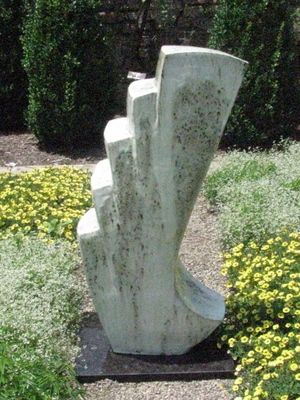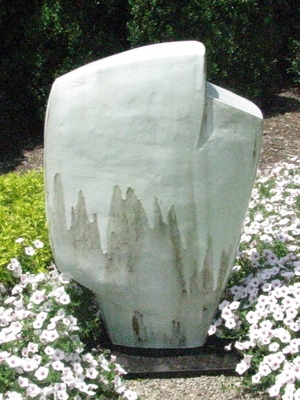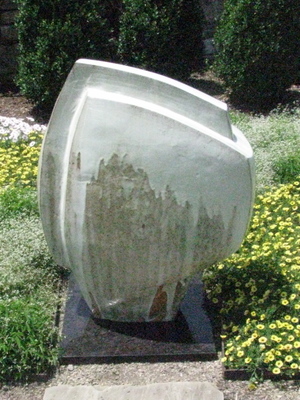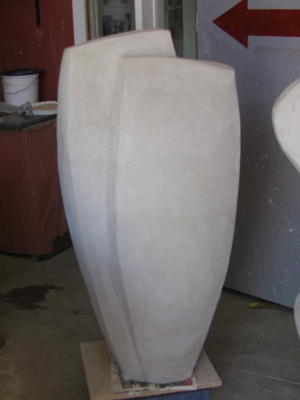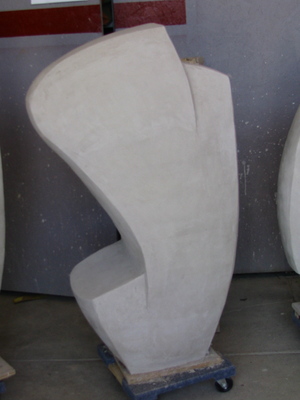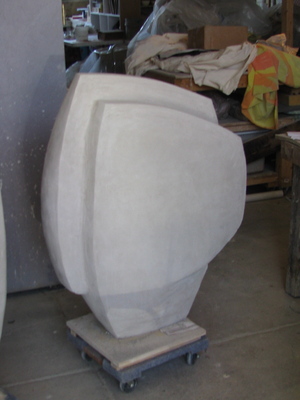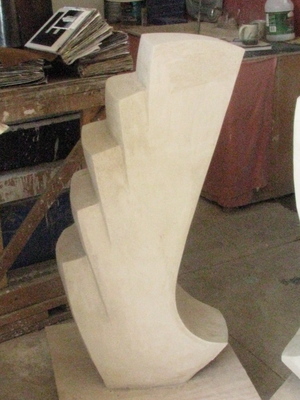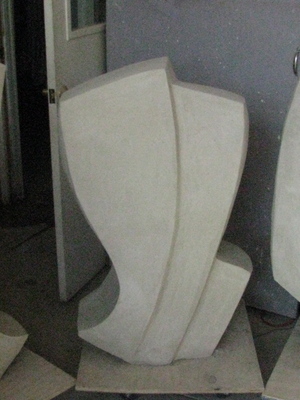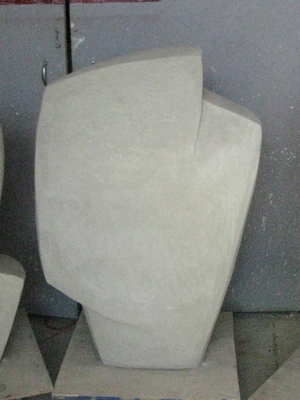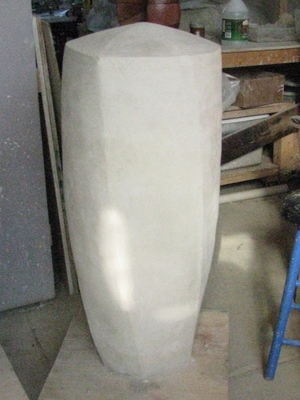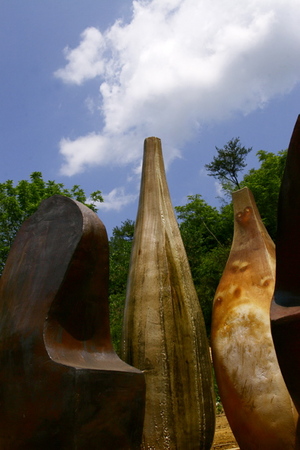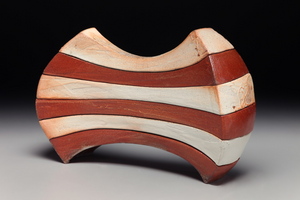After letting the kiln cool for about a week we unloaded the work, brought it back to the studio and began cleaning it. Because of the nature of wood fired ceramics in general and the Bizen clay and loading styles in particular, the firing itself is etched into the unglazed surface of the pottery. This natural patina is the result of a dynamic interaction between clay, form, loading, and firing. Not only do these surface effects give each piece its own unique character, by observing the wares still stacked in the kiln after the firing, much can be learned about the firing itself. For example, we can tell which areas of the kiln received the most ash deposits, which areas were hot and cool, how high the charcoal was, where the flame burned with an abundance of oxygen and where it burned with an abundance of fuel. All of this information can then be used when planning the next firing.
I wrote in an earlier post that, for me, working with clay is essentially a collaboration with a material rather than a dominance over it. I think firing a wood kiln is similar. Each kiln is different, each firing is different, and even the reaction of the kiln to each stoke of wood may be different. By working with the kiln--during a firing and from firing to firing--success, in my opinion, is more likely.
After the firing we took all of the work out of the kiln, brought it back to the kiln and then began cleaning it. To clean wood fired ceramics a variety of tools are used: blocks of silicon carbide take off the large burrs, sandpaper is used to make the surface more friendly to the touch, and if necessary, a grinder is used for large or stubborn protrusions. Finally the work is washed in several changes of clean water to remove the dust from cleaning and any remaining loose ash.
After the work is cleaned, it is organized and certain pieces are selected for upcoming exhibitions.
The timing of my stay in Bizen was such that my first activity was processing clay and my last was cleaning the fired work. In between, I got to experience helping Sensei make work, peparing for the firing, loading firing and unloading as well as various assorted tasks. Thus, I was able to experience a full cycle of making work in the studio of Isezaki Jun Sensei.
In addition, I made several life long friends, learned a great deal of Japanese, and grew in many other ways. This experience was particularily interesting to me because of my prior experiences. About three years ago I finished a two year apprenticeship to Jeff Shapiro. Since that time I have worked as an independent artist and made my own work. Much of what I leared at Shapiro's as well as much of what I employ in my own work has roots in Japan and particularily Bizen. Therefore, to apprentice again, this time in Japan, after working on my own for several years, felt very much like I was tracing my own artistic lineage. Though I do not consider myself a traditional artist, I certainly recognize the importance of tradition on my work and humbly regard my self as the grateful recipient of several traditions.
More pictures of my time in Japan can be found at
picasaweb.google.com/superduperdog3
Also, with the approval of Isezaki Sensei I made a short film about my experience. You can watch it here.
vimeo.com/2929505
There is a password that is required. It is "woodfire."
We have just begun firing. After three months of hard work by Isezaki Sensei, Koichiro-san (his son), Kibata-san (the oldest apprentice), Ishida-san (the other apprentice), Hatori-san (an employee who mostly handles the wrapping and shipping of finished work, but also helps where ever needed), and myself, this the culmination. Last week we loaded hundreds of Sensei’s pieces into the kiln. While in many places in Japan and around the world the firing’s primary purpose is to transform the clay into ceramic and the applied glazes into hard glass, in Bizen the firing as another purpose as well. Traditionally no glazes are used on the pottery and so it is the firing itself which gives the work its finished patina. To be more accurate, it is the interaction of the clay, the form, the loading and the firing which patina the work. In Japanese the term for this kind of work is ‘yakishime.’ In english, as is often the case with woodfired ceramics, we do not have one concise word for it, though it is usually referred to as ‘natural ash glazed ceramics.’
Isezaki Sensei's Anagama
Because the path of the flame through the kiln and wares in extremely important in determining what the final results will be both on individual pieces as well as on the kiln load as a whole, great care is taken during the loading and much consideration is given to directing the flame. During the firing the flame behaves much like water, taking the path of least resistance, speeding up as it constricts, swirling and eddying as it flows around the wares.
Loading the back of the kiln
This style of kiln is called an ‘anagama’ and is basically a tube running at an incline up a hill. The pitch of anagama kilns vary a great deal but Sensei’s is fairly steep, almost completely eliminating the need for a chimney. Infact, the chimney on this kiln is only about two feet tall.
For the next ten days we will take turns stoking the kiln continuously in eight hour shifts. Typically during kiln firings my favorite shift is the overnight shift because of the stillness, but this time Ishida-san and I are on the 4 pm to Midnight.
Sensei pulling a teabowl from the kiln as the kiln approaches top temperature. Each firing a few pieces are selected for this technique which is called 'hikidashi.' The results are dramatically different from the work left in the kiln to cool naturally.
Excavating clay from under a local rice field.
Bizen clay, often dug from under local rice fields, has very high levels of organic matter. Therefore, the temperature of the kiln must be raised very slowly in order to burn out these impurities. If the temperature goes up to quickly, the escaping gasses can cause bloating. We are currently raising the temperature by 5 degrees celsius per hour.
This style of firing is incredibly labor intensive, somewhat unpredictable, and relatively expensive. However, as you see in my next post, the results speak for themselves.
More pictures are at
picasaweb.google.com/superduperdog3
Some of my work
Thanks for reading!
Eric
I have been working in the studio of Mr. Jun Isezaki in Imbe, Bizen, Japan for a little over a month. In addition to myself, Isezaki has two other apprentices right now, Kibata and Ishida. And in addition to their jobs as apprentices I have recruited them both as de facto Japanese instructors. The first few weeks after my arrival I learned what feels like a tremendous amount of Japanese as we worked together on various projects.
Crushing the dry clay by hand
The timing of my stay here as worked out perfectly insofar as I will get to experience an entire making cycle. My first job when I arrived was manually crushing natural dry clay and looking for lime. Auspiciously this was the exact same task I was given on the first day of my apprenticeship to Jeff Shapiro. (Shapiro is also my connection to Japan and to Isezaki). I think crushing clay and looking closely at it is a good place to start an apprenticeship. Also, during the first few days of my time here Isezaki’s son Koichiro (who also studied with Shapiro) began loading his own anagama (wood kiln) and invited me to help. Loading is my favorite part of the process and, in my humble opinion, just as important as the firing in terms of surface development. Observing and helping with this loading and firing was extremely interesting since it was generally similar to the methods I am familiar with and therefore I felt I could understand his decisions. However, every wood fire ceramist does things a bit differently and it’s always interesting to witness this. Koichiro Isezaki really is one of the very finest young potters working today.
Constructing a basic form
Each day here starts with a comprehensive cleaning of the studio which includes sweeping the studio and out door work spaces, wetting the clay floor (which, incidentally, is fantastic to stand on-much better than concrete) and generally putting everything back in its place. After cleaning, we begin the work of the day. While the specific tasks vary and often we will be working on several projects at once, things are very rhythmic and cyclical.
The kiln of Bizen potter, Kondo-san
As I mentioned above, I was fortunate enough to arrive at the beginning of a cycle. Making ceramics begins with making clay. While many potters use commercial clay (clay that has been mined on a large scale and heavily refined), Mr. Isezaki uses almost exclusively local, unprocessed clay. First the dry clay is crushed by hand and large stones, twigs and other material are picked out (though some stones are left in as they add to the character of the clay and thus to the finished work). The clay is then put into large wooden boxes with water to hydrate it. After several days or weeks the clay is taken out and put into terracotta pots to dry it back to working consistency and finally it is run through a pug mill (a machine which mixes and compresses the clay). Mr Isezaki used a number of different natural clays which are blended in different proportions depending on the form he is making.
Shards from the site of a 1000 year old kiln
After the clay is prepared, we can begin making the forms. Some forms Mr. Isezaki makes entirely by himself and some are begun by the apprentices and finished by him. Roughing out simple forms to his specifications can be very challenging. While I am certainly not an expert potter, I am not a novice either. It has been very humbling to work in this studio. For example, to take a given weight of clay and make a given size slab by pounding it out by hand without cutting or touching the edges requires that every time the clay is touched it is touched consciously and deliberately. The slight changes in dimension that occur with every touch must be monitored closely so that the whole piece of clay is slowly and evenly transformed. As I said, I am not a novice, but I am learning a whole new level of working with the clay.
In addition to making clay and preparing forms, there are many other tasks around the studio. We have already begun preparing for the firing. It took the other two apprentices and me several days to clean the kiln and and all of the kiln furniture (the shelves and posts that the pottery is placed on in the kiln). Other tasks in preparation for the firing include pounding rice straw (which is used to burn orange lines into the potter) and making “bota” (slabs of refractory clay of various shapes used to influence the flame patterns left on the pottery).
More pictures are at
picasaweb.google.com/superduperdog3

